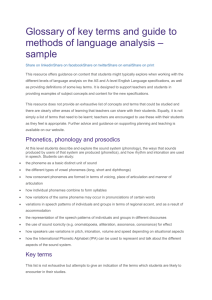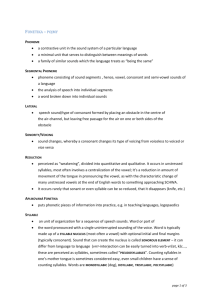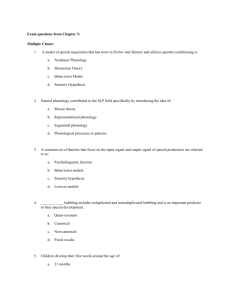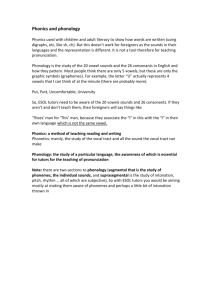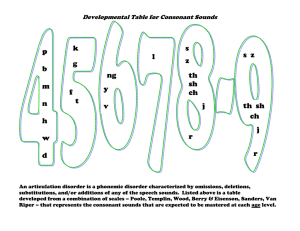introduction to linguistics
advertisement
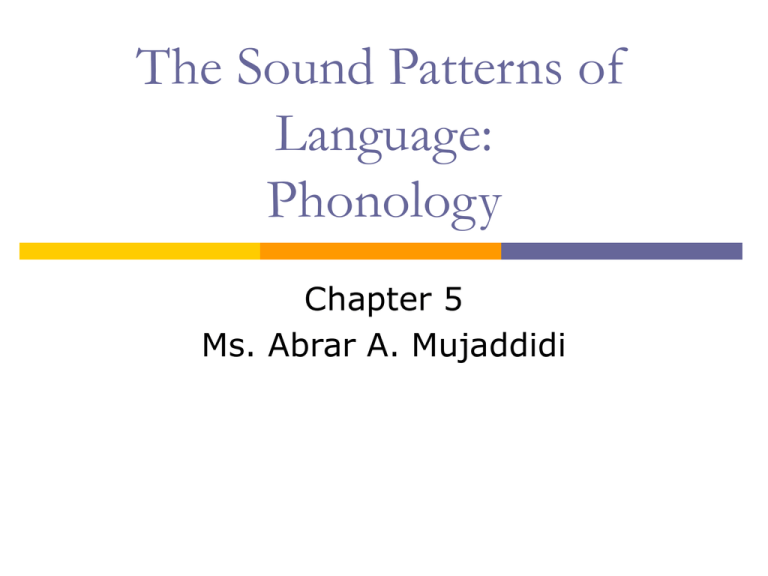
The Sound Patterns of Language: Phonology Chapter 5 Ms. Abrar A. Mujaddidi Introduction In the previous chapter, we have investigated the physical production of speech sounds. What made that investigation possible? YET; Every individual has a vocal tract that is physically different than others’. So, every individual will pronounce sounds differently. cont., Moreover, every individual will pronounce the same word differently on different occasions. What makes us recognize all the different versions of the word ‘me’ as [mi], not as any other word? Phonology Phonology is the description of the systems and patterns of speech sounds in a language. It is based on a theory of what every speaker of a language unconsciously knows about sound patterns of that language. Provide examples.. cont, Phonology is concerned with the abstract or mental aspects of sounds in language. Compare to phonetics? Phonetics is the physical properties of speech sounds, e.g. how the sound is physically produced. Phonology serves as the underlying design for all the variations in different physical articulations of a sound type in different contexts. cont., We think of the [t] sound in the following words to be the same: - tar - star - writer - eighth What we mean is that in the phonology of English they are all represented inn the same way, but physically, they are all different! Phonemes Phonemes: meaning-distinguishing sounds in a language. Phonemes are written between slashes e.g. /t/ Phonemes function contrastively e.g. /f/ and /v/ fat vat fine vine cont., To determine the phonemes that exist in a language: we use the contrastive property: if we substitute one sound for another in a word and there is a change in meaning, then the two sounds represent different phonemes. e.g. night vs. kite cont., The basic phonemes of English are listed in the consonant and vowel charts of English. The features of each sound are used to create these charts. Those features are used to distinguish one phoneme from another. We use the (+) and (-) to mark the presence or absence of the phonemic features. e.g. /p/ [ -voice, +bilabial, +stop] /k/ [ -voice, +velar, + stop] cont., Natural class: /p/ [ -voice, +bilabial, +stop] /k/ [ -voice, +velar, + stop] because these two sounds share some features, they are described sometimes as members of a natural class of sounds. Sounds which share common features behave phonologically in a similar way. A sound which does not share these features behave differently. cont., Cont. natural class: e.g. /v/ [+voice, +labiodental, +fricative] So, /v/ cannot be put in the same ‘natural’ class of sounds as /p/ and /k/. The idea of natural class can help in explaining why we have words in English starting with /pl-/ and /kl-/ but not with /vl-/. Phones and allophones We established earlier that a phoneme is the abstract unit (in the mind). There are many versions of that unit regularly produced in actual speech (in the mouth). we can describe these different versions as phones. cont., Phones are: phonetic units and appear in square brackets. We can have several versions of one phoneme. These are allophones of one phoneme. e.g. /t/ 1 phone [tʰ] tar phoneme 1 phone [ 1phone [ ] writer ] eighth Allophones cont., The basic distinction between phonemes and allophones: - In phonemes: if we substitute one phoneme for another will result in a word with a different meaning (and of course pronunciation). e.g. tar vs. bar - When substituting allophones, only unusual pronunciations of the same word occur. e.g. فأرvs. ڤأر cont., Another example to clarify the idea of phonemes vs. allophones: vowel nasalization -Phonemic in French e.g. [so] (pail) [sõ] (sound) - Non-phonemic in English; since nasalizing a vowel does not change a meaning of a word. - Try it out! Minimal pairs and sets How do we test phonemes? We test phonemes by pairs and sets of words. Minimal pair: When two words are identical in form except for a contrast in one phoneme occurring in the same position, then the two words are described a minimal pair. e.g. bat vs. fat bat vs. bet cont., Minimal sets: When a group of words can be differentiated by changing one phoneme in the same position in the word, then we have a minimal set. e.g. feat fit fat fate foot Phonotactics In each language, there are a number of patterns in the types of sounds combinations permitted. e.g. In English, we can create new words vig or las, but not fsig or rnig! Phonotactics are the permitted arrangements of sounds in a a language are part of the every speaker’s phonological knowledge. cont., vocabulary gaps accidental gaps e.g. vig or lig systematic gaps fsig or rnig Syllables and Clusters A syllable must contain a vowel or a vowel-like sound. The most common type of syllable in a language has a consonant as well. When describing syllables: C = consonant V = vowel cont., syllable onset (optional) one or more consonants rhyme Nucleus (not optional) vowel coda (optional) one or more consonants cont., syllables open syllables Syllables which end in a vowel and no coda closed syllables syllables which end in a coda ‘consonants’ cont., Consonant clusters: both the onset and the coda can consist of more that one consonant e.g. green (CCVC) street (CCCVC) post (CVCC) cont., In English, consonant clusters of more than two consonants follow a certain rule: 1st consonant s 2nd consonant p t k 3rd consonant w r l Co-articulation effects We have been describing the production of speech in slow motion. On the contrary, our speech is fast and spontaneous. Our articulators move very quickly from one sound to another without stopping. cont., Co-articulation: co-articulation is the process of making one sound almost at the same time of making the next sound. Examples of Co-articulation effects: 1. Assimilation 2. Elision Assimilation Assimilation occurs when two sounds occur in sequence and some aspect of one segment is taken or ‘copied’ by the other. Examples of Assimilation: Vowel nasalization: as in pin or pan. Velarization: as in I can go. Vowel reduction: you and me. 1. 2. 3. Elision Elision is the process of not pronouncing a sound segment that might be present in the deliberately careful pronunciation. Examples of elision: You and me Friendship aspects 1. 2. 3. We are done with ‘phonology’!!
